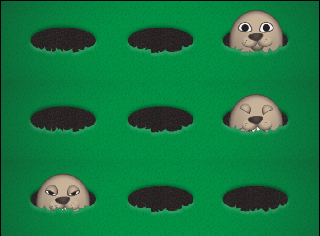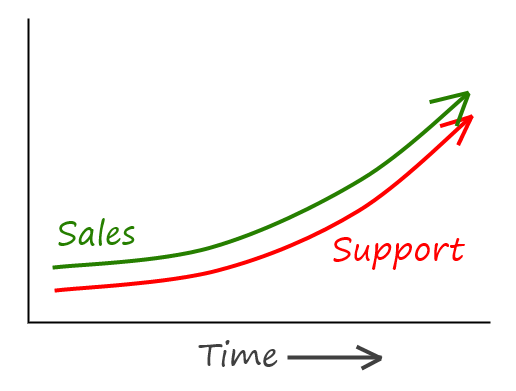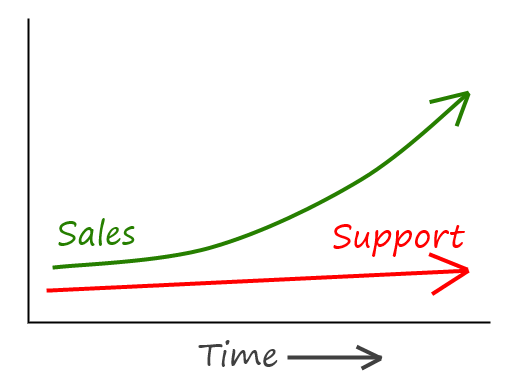
How to Win At Whac-a-Mole: The Secret To Truly Sustainable Support
Supporting your customers can feel like an endless game of whack-a-mole.

No sooner have you answered one support request than another one pops up! Whack! Whack! Whack!
And as your business grows, the problems grow right along with it. If you suck at support then every ounce of success only brings more problems!
Success === Failure

If the support burden grows inline with the growth of the company then you are in for a terrible life.
But it doesn't have to be this way!
It is entirely possible to make a product that looks after itself. It brings in passive income, from zero touch sales, and the support queue doesn't grow deeper even as the customer numbers double and double and double.

Improve the Product
Every support request is an opportunity to improve the product.
Is this a bug? Fix it. But also: what other bugs like this are lying dormant in the product?
Was something unclear in the product, i.e. a usability bug? How can this be addressed?
Continual improvement has powerful long term benefits, the mathematics of which are not readily apparent to the human mind. It is similar to compound interest:
The most powerful force in the universe is compound interest.
—Almost definitely not Albert Einstein
Put the FAQ in front of the support queue
If customers are asking questions that are already answered on your web site, or in your documentation, then you have a discoverability problem.
You need to make the answers more easily discoverable. And you need to make it easy for customers to find the relevant documentation before contacting support.
Make the FAQ Super-Easy to Edit
If you're answering the same question again and again but you haven't put it in your FAQ, why not?
Often there are little pieces of friction that stand between you and an up to date FAQ. You need to systematically remove every piece of friction in that chain.

Break down all the steps in updating your FAQ.
Find which ones are hard or which ones make you hesitate. (Look for the hesitation!)
Fix the problems, remove the friction.... be a FAQ-making legend.
Example steps:
- You notice "I've heard this before"
- You think "I need to add it to the FAQ"
- You write down the question (Where? how?)
- You write down the answer (Extracted from support tickets... don't get fancy)
- You publish the updated FAQ. (How? Is this as easy as it could be?)
- Done. (Really? what other steps do you take?)
If you make it super easy to edit and update the FAQ — your support burden will be significantly lowered over time.
Fire A Customer!
The customer is always right.
Um, no. That is nonsense.
When you run a business it is OK to fire a customer on occasion.
It's not something that happens often, but there are times when you need to politely inform a customer that you are going to refund their money, wish them all the best, and bid them farewell.
Don't do it when you're angry — don't do it in the middle of a 'hot moment'. But don't put up with a pattern of repeated abuse from a customer. If you don't believe you would ever fire a customer, you just haven't met the right customer yet. They make themselves known. Believe me.
Be super nice about it. Angering them further is not going to do yourself any favors. But showing them the door will stop them from draining your energy and your sense of well-being.
Having said that, sometimes good customers are just having a bad week. When you are confronted by the Angry Customer, look to see if it's an ongoing problem or if it's just happening for the first time. Remember that the anger isn't your problem, it's their problem. Try not to engage them, or challenge them directly. If the customer is just having a bad day they'll calm down all by themselves.
Remove the "Killer" Feature
Some features are "killer" features, not in the sense that they make your product a runaway success, but in the sense that they "kill" your ability to support the product.
Take an honest look at the support queue and you'll find Vilfredo Pareto hiding in there, muttering something about "80% of the support comes from 20% of the features."
First you need to see how those troublesome features can be made more robust. Ugly code may be needed. A lot of if/then cases. Multiple levels of error handling and retries. Whatever it takes to robustify that beast!
Next you may need more logging. Are you unable to understand what's truly going on? Are there things you are not seeing?
Failing that, how much do those features contribute to sales? You must consider the possibility of removing the feature.
If existing customers are getting terrific benefits from it, then you might leave it in place for existing paid customers, but stop it from appearing for new customers. (Easier to remove it entirely, so if you're going to make it either-or, then at least talk to the existing customers to find out how they feel about it.)
Snippets to the rescue!
Your helpdesk software should include some kind of snippet feature that lets you paste in common snippets of helpful text, without rewriting them from scratch every time.
This only makes it cheaper to whack an individual mole — it doesn't decrease the number and frequency of the moles themselves. So it's not a terrific solution. But worth spending the time on.
Turn Support Into An Asset
There are two different ways support can be an asset.
Firstly, you can charge for support. For a sufficiently complex product, sold to a sufficiently cashed up customer, this is a must. Then increased support means increased income.
Second — support is a source of new product ideas. The support queue gives you a steady stream of real world information about people's needs and their behavior. This is better than the jumbled up untested ideas that bounce around inside your addled mind.
The greatest source of innovation is misuse.
—Clay Christensen said something a bit like this.
How are people misusing your product? What's the product they really need?
Third — support tickets give you the exact words and needs of your customers, and this is the greatest source of content for your ongoing educational content campaign. Mine your support queue for customer questions, needs, fears, and (simply) vocabulary to get the words from their mouths in front of the eyeballs of a new audience.
My book "Choose Your First Product" is available now.
It gives you 4 easy steps to find and validate a humble product idea.